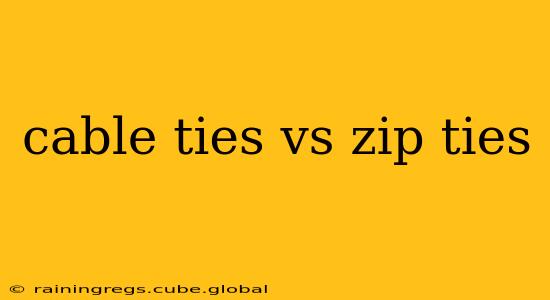The terms "cable ties" and "zip ties" are often used interchangeably, leading to confusion. While they essentially refer to the same fastening device—a type of plastic fastening strap—there are subtle differences in usage and connotation. This comprehensive guide will delve into these nuances and explore the various applications of these versatile tools.
What are Cable Ties and Zip Ties?
Both cable ties and zip ties are essentially the same thing: plastic straps with a locking mechanism that allows them to be secured around objects. They are made from various materials, most commonly nylon, and come in a wide range of sizes and strengths. Their simple design allows for quick and easy bundling of cables, wires, and other items, making them indispensable in various industries and households. The difference often lies in context and regional preference. "Zip tie" is the more common term in North America, while "cable tie" is more prevalent in other parts of the world.
Are Cable Ties and Zip Ties Made of the Same Material?
While the most common material is nylon, both cable ties and zip ties can be made from other materials, including:
- Nylon 66: This is the most frequently used material due to its strength, durability, and resistance to chemicals and UV light. It offers a good balance of strength and flexibility.
- High-impact Polypropylene: This material is often used for applications requiring higher impact resistance.
- Polyethylene: A more flexible and less expensive option but with reduced strength.
- Stainless Steel: For applications demanding extreme durability and resistance to high temperatures.
The specific material used depends on the intended application and the required strength and environmental resistance. The choice of material is usually reflected in the tie's specifications and color coding.
What is the Difference in Strength and Durability?
The strength and durability of both cable ties and zip ties depend primarily on the material they're made from and their dimensions (width and thickness). Thicker ties are generally stronger. Nylon 66 ties are known for their superior durability and strength compared to polyethylene ties. Always check the manufacturer's specifications for the exact tensile strength of a particular tie before using it in critical applications.
What are the Common Uses of Cable Ties/Zip Ties?
The uses are nearly limitless, covering a vast array of applications:
- Bundling Cables and Wires: This is perhaps their most common application, keeping cables organized and preventing tangles.
- Home Repair and Organization: Securing cords, hoses, and other household items.
- Automotive Repair and Maintenance: Bundling wires under the hood or securing parts.
- Industrial Applications: Securing parts, bundling materials, and supporting structures.
- Gardening: Supporting climbing plants or securing branches.
- Electronics: Securing components within electronic devices.
How to Choose the Right Cable Tie/Zip Tie?
Selecting the appropriate cable tie depends on several factors:
- Bundle Diameter: Measure the diameter of the cables or items you're bundling to choose an appropriately sized tie.
- Tensile Strength: Consider the required strength to secure the items effectively. Heavier bundles require stronger ties.
- Material: Select the material based on the environment and potential exposure to chemicals, UV light, or extreme temperatures.
- Length: Choose a tie length that allows for sufficient overlap and secure locking.
Are Cable Ties Reusable?
No, standard cable ties are not reusable. Once the locking mechanism is engaged, it cannot be easily undone without cutting the tie. However, reusable cable ties are available, often using a ratchet mechanism instead of a one-time locking mechanism. These reusable options allow for repeated tightening and adjustments.
What is the Best Way to Cut a Zip Tie?
Using wire cutters or heavy-duty scissors is the most effective and safest method for cutting zip ties. Avoid using your teeth or less sturdy tools to prevent injury or damage to the tie.
What are the Safety Precautions When Using Cable Ties/Zip Ties?
- Always use appropriately sized ties for the job. Overly tight ties can damage cables or objects.
- Never use ties near moving parts or high-voltage equipment.
- Dispose of used ties properly to avoid environmental hazards.
- Be aware of sharp edges when cutting ties.
This comprehensive guide provides a thorough understanding of the subtle differences between cable ties and zip ties, their various uses, and safety precautions to consider. Whether you're a professional technician or a homeowner, understanding these details ensures safe and effective usage.
